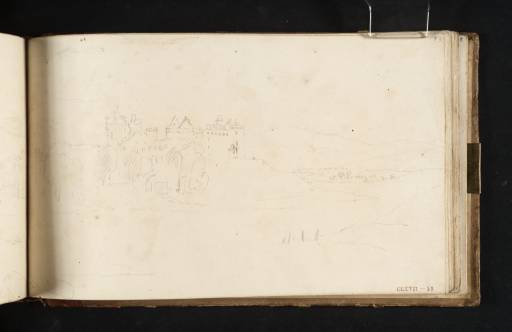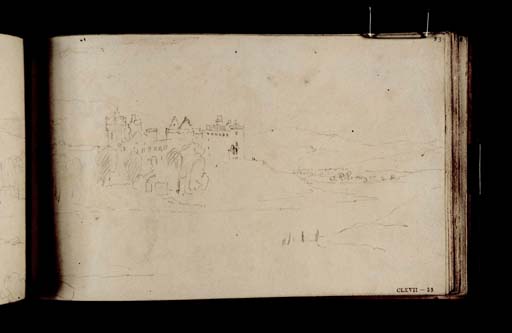Joseph Mallord William Turner Linlithgow 1818
Image 1 of 2
Joseph Mallord William Turner,
Linlithgow
1818
Joseph Mallord William Turner 1775–1851
Folio 56 Recto:
Linlithgow 1818
D13679
Turner Bequest CLXVII 53
Turner Bequest CLXVII 53
Pencil on white wove paper, 112 x 186 mm
Inscribed in blue ink ‘53’ top right
Stamped in black ‘CLXVII 53’ bottom right
Inscribed in blue ink ‘53’ top right
Stamped in black ‘CLXVII 53’ bottom right
Accepted by the nation as part of the Turner Bequest 1856
References
1909
A.J. Finberg, A Complete Inventory of the Drawings of the Turner Bequest, London 1909, vol.I, p.486, CLXVII 53, as ‘Linlithgow.’.
1979
Andrew Wilton, J.M.W. Turner: His Life and Work, Fribourg 1979, p.426 under cat.1068 as CLXVII 52–54.
1983
Timothy Clifford, J.M.W. Turner: Aquarelles de la City Art Gallery, Manchester, exhibition catalogue, Musée des Beaux-Arts, Bordeaux 1983, p.39 under cat.10c.
1984
Timothy Clifford and Torsten Gunnarsson, J.M.W. Turner: Akvareller Målningar Grafik, exhibition catalogue, Nationalmuseum, Stockholm 1984, p.48 cat.23.
1985
Timothy Clifford and Shuji Yashiro, Turner at Manchester, exhibition catalogue, Odakyu Grand Gallery, Tokyo 1985, p.[51], cat.18.
1997
Eric Shanes, Turner’s Watercolour Explorations 1810–1842, exhibition catalogue, Clore Gallery, Tate Gallery, London 1997, p.63 cat.46.
1999
Katrina Thomson, Turner and Sir Walter Scott: The Provincial Antiquities and Picturesque Scenery of Scotland, exhibition catalogue, National Gallery of Scotland, Edinburgh 1999, p.28 fig.10.
The sketch on this page and folio 55 verso (D13678; CLXX 52a) is one of three for which Finberg notes ‘see Engraving in Part VI of Scott’s “Antiquities”’,1 referring to the engraving of Linlithgow Palace, 1822 by Robert Wallis after Turner’s 1821 watercolour (Manchester City Galleries).2 The other two relevant pages are the verso of the present page (folio 56 verso; D13680; CLXVII 53a) which contains three sketches of the palace from around the north-east and a double-page sketch in the Edinburgh 1818 sketchbook (Tate D13514–D13515; CLXVI 33a–34).
While the final composition does not closely resemble this sketch, the appearance of Linlithgow Palace and St Michael’s Church do derive most directly from it and the Edinburgh, 1818 sketchbook drawing. They are seen here from the north-east across Linlithgow Loch with part of the town visible at the right and the Bathgate Hills in the distance beyond. The sketch extends to the left where on folios 55 verso is depicted the rest of the loch to the east and the south bank (D13678; CLXVII 52a).
This provides all the architectural details of the building; the position of the windows, the roofless crow-step gables, the east entrance below which is a large quarter-circle stone buttress (folio 46; D13661; CLXVII 44), and the tower of St Michael’s with its old open crown spire (see folios 43 verso–44; D13656–D13657; CLXVII 41a–42). Evidence that Turner referred to this drawing when he made his watercolour is found on folio 55 verso, where a small patch of watercolour paint matches the colour used for the loch in the final work. However, the exact layout of the castle and church and their orientation is more closely based on the outline sketch in the Edinburgh book which is from a slightly more easterly vantage point, so that more of the east side of the palace is shown, and the church is further to the left of the Palace.
Eric Shanes has pointed out that the watercolour follows the sketches in depicting Linlithgow in the early evening ‘for with the light entering from the right both landscapes are therefore viewed towards the end of day’.3 This is perhaps apparent in the sketches on folio 56 verso where the left side of the trees and buildings are shaded.4
Thomas Ardill
March 2008
It seems unlikely, however, that these sketches were made very late in the day as there follows in the sketchbook views of the Firth of Forth near Blackness Castle which Turner is likely to have made on the fifteen-mile return journey to Edinburgh from Linlithgow. It is doubtful whether Turner would have had time to make these sketches if the light was already fading before he departed.
How to cite
Thomas Ardill, ‘Linlithgow 1818 by Joseph Mallord William Turner’, catalogue entry, March 2008, in David Blayney Brown (ed.), J.M.W. Turner: Sketchbooks, Drawings and Watercolours, Tate Research Publication, December 2012, https://www


